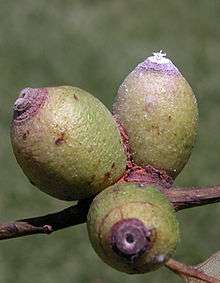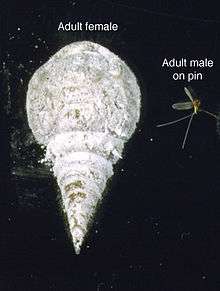Apiomorpha
Apiomorpha is a genus of scale insect that induces galls on species of Eucalyptus. Galls are initiated by first-instar nymphs (crawlers) on new plant growth and, when mature, the galls exhibit marked sexual dimorphism. Those induced by females are among the largest and most spectacular of arthropod-induced galls whereas those of males are small and most are tubular.[1] Apiomorpha is known only from Australia and New Guinea although its host, Eucalyptus, has a wider distribution into Indonesia as well.
| Apiomorpha | |
|---|---|
 | |
| Apiomorpha conica galls of 3 adult females. | |
| Scientific classification | |
| Kingdom: | |
| Phylum: | |
| Class: | |
| Order: | |
| Suborder: | |
| Superfamily: | |
| Family: | |
| Genus: | Apiomorpha Rübsaamen |
| species | |
|
See text | |
Apiomorpha is currently classified in the Eriococcidae,[2] but this family is not monophyletic.[3]
Morphology

Like other scale insects, Apiomorpha is highly sexually dimorphic.[1] Adult females are wingless, have very small (or no) eyes, and their legs are short and stubby. A female remains within the gall she initiated when a crawler, mating through the small apical opening of her gall. She reproduces inside the gall and her tiny offspring (≤ 0.4 mm) escape through the same small opening. Adult females of Apiomorpha can range in length from 2 mm to 45 mm, depending on species, and can live up to five years as adults.[4] In contrast, adult males of Apiomorpha are small (about 1 mm in length) and winged. Like males of other eriococcids, they do not have a mouth and, instead, have an extra pair of eyes on the underside of their head (i.e., they have four eyes, two on top and two underneath). Males leave their galls as adults and search for females. They are weak fliers and typically walk on their host plant looking for females before taking to the air. After leaving their gall, adult males only live about one day.[4]
Species
- Apiomorpha amarooensis
- Apiomorpha annulata
- Apiomorpha attenuate
- Apiomorpha baeuerleni
- Apiomorpha calycina
- Apiomorpha conica
- Apiomorpha cucurbita
- Apiomorpha densispinosa[1]
- Apiomorpha dipsaciformis
- Apiomorpha duplex
- Apiomorpha excupula
- Apiomorpha floralis[5][6]
- Apiomorpha frenchi
- Apiomorpha gongylocarpae[7]
- Apiomorpha gullanae[8]
- Apiomorpha helmsii
- Apiomorpha hilli
- Apiomorpha intermedia[1]
- Apiomorpha jucundacrispi[7]
- Apiomorpha karschi
- Apiomorpha longiloba
- Apiomorpha macqueeni
- Apiomorpha maliformis
- Apiomorpha malleeacola[1]
- Apiomorpha munita
- Apiomorpha nookara[9]
- Apiomorpha ovicola [10][6]
- Apiomorpha ovicoloides
- Apiomorpha pedunculata
- Apiomorpha pharetrata
- Apiomorpha pileata (type species)
- Apiomorpha pomaphora[11]
- Apiomorpha regularis
- Apiomorpha rosaeformis
- Apiomorpha sessilis
- Apiomorpha sloanei
- Apiomorpha spinifer
- Apiomorpha strombylosa
- Apiomorpha subconica
- Apiomorpha tepperi[1]
- Apiomorpha thorntoni
- Apiomorpha urnalis
- Apiomorpha variabilis
- Apiomorpha withersi
References
- Gullan, P.J. 1984. A revision of the gall-forming coccoid genus Apiomorpha Rübsaamen (Homoptera: Eriococcidae: Apiomorphinae). Aust. J. Zool. Suppl. Ser. 97:1-203. doi:10.1071/AJZS097
- Miller, D. & Ben-Dov, Y. 2005. ScaleNet Archived 2013-04-04 at the Wayback Machine
- Cook, L.G., Gullan, P.J. & Trueman, H.E. 2002. A preliminary phylogeny of the scale insects (Hemiptera: Sternorrhyncha: Coccoidea) based on nuclear small-subunit ribosomal DNA. Molecular Phylogenetics and Evolution 25(1): 43-52. DOI: 10.1016/S1055-7903(02)00248-8
- Cook, L. G. and P. J. Gullan. 2001. Longevity and reproduction in Apiomorpha Rübsaamen (Hemiptera: Sternorrhyncha: Coccoidea). Bollettino di Zoologia agraria e Bachicoltura 33:259-265.
- Froggatt, W. W. (1898). "Notes on the subfamily Brachyscelinae, with descriptions of new species. Part V.". Proceedings of the Linnean Society of New South Wales. 23: 370–379. ISSN 1839-7263.
- Mills, Penelope J.; Gullan, Penny G.; Cook, Lyn G. (2017). "Nomenclatural changes in the Australasian gall-inducing genus Apiomorpha Rübsaamen (Hemiptera: Coccomorpha: Eriococcidae)". Zootaxa. 4250 (5): 484–488. doi:10.11646/zootaxa.4250.5.6. ISSN 1175-5334.
- Mills, Penelope J.; Semple, Thomas L.; Garland, Kathleen L. S.; Cook, Lyn G. (2016). "Two recently discovered species of Apiomorpha (Hemiptera: Eriococcidae) feeding on eudesmid eucalypts in Western Australia reaffirm host conservatism in this gall-inducing scale insect genus". Invertebrate Systematics. 30 (3): 255–273. doi:10.1071/IS15039. ISSN 1445-5226.
- Cook, Lyn G (2003). "Apiomorpha gullanae sp. n., an unusual new species of gall-inducing scale insect (Hemiptera: Eriococcidae)". Australian Journal of Entomology. 42 (4): 327–333. doi:10.1046/j.1440-6055.2003.00370.x. ISSN 1326-6756.
- Mills P.J., Macdonald M.L., Rigby L.M. & Cook L.G. (2011). A recently discovered species of Apiomorpha Rübsaamen (Hemiptera: Coccoidea: Eriococcidae) with unusual gall morphology. Zootaxa, 3093, 55-63.
- Schrader, H. L. (1863). "Observations on certain gall-making Coccidae of Australia". Transactions of the Entomological Society of New South Wales. 1: 1–6. ISSN 1321-6244.
- Gullan P.J. & Jones M.G. (1989). A new species of gall-forming coccoid (Insecta: Homoptera: Eriococcidae) from Western Australia. Records of the Western Australian Museum. 14, 321-329.